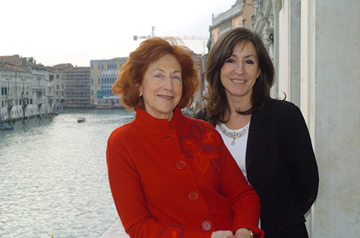A biennial in Venice
On Thursday 9 June 2005, the art world congregated in Venice, flash-mob style, for the opening day of the oldest and greatest biennial in a world that has gone biennial crazy. These exhibitions are a showcase for national art, coming together like an advertisement for a world of peace, cheap travel, and no frontiers.

Maria del Corral and Rosa Martinez, the global curators in charge of the 51st exhibition held the media’s attention in the months prior to the opening due to coupling number, gender and nationality. All of these transgressions promised an intense and controversial show. Instead, the Italian Pavilion’s ‘The Experience of Art’ (Del Corral) and the Arsenale’s ‘Always a little further’ (Martinez) were both safely curated shows, devoid of radicalism, perhaps due to the fact that this year’s Biennale is not an artist’s show. It is not even an audience show like the precedent one, entitled ‘The Dictatorship of the Viewer’, supposedly was. The 51st Venice Biennale is entirely a curator’s exhibition, where the selection of works is biased from the outset:
I have decided to work with certain authors, who have accompanied me along my lengthy artistic itinerary, and to add many other names to this list: young artists who will accompany me through a similar experience.
Maria Del Corral, The Experience of Art Press release
One of the functions of the curator is to reduce the background noise, to assign value and to organise syntax and discourses, which introduce sense into the unending traffic of messages.
Rosa Martinez, Always a Little Further Press Release
The result is a very coherent and neat exhibition, but not so different from what one could find, say, at the Tate Modern or MoMA. The works are not risky, critical or sceptical and the majority of curated exhibitions and national proposals conform to an international art style, a sanitised view of art, culture and thought. An example of this may be the Guerrilla Girls, who were selected to be displayed in the very first room of the Arsenale, are famous for their guerrilla art, mainly done outside established and safe art spaces. For this Biennale, they show a photographic display of feminist oriented visuals and statements that go to highlight the fact that they have been tamed by the art gallery machinery.

To find any challenging, unconventional proposal going beyond the expected painting, installation and video projection, one had to follow people’s song humming at the Giardini and track them down to their source. Tino Sehgal’s work in the German Pavilion attacks the viewer from the moment he closes the entrance door. Inside a group of people have their look fixed on the newcomers, the space being empty. Suddenly, the gallery attendants are brought to life by Art’s energy and start dancing around accosting the public with their catchy tune: “This is so contemporary, contemporary, contemporary. Uuuuuh!”, a piece verbally signed and dated by the artist himself. The second piece by Sehgal also involves gallery attendants taking control of an empty space but this time, they politely talk to viewers. I wait to be spoken to. Remotely through his actor puppets, Tino Sehgal promises to pay back half of my ticket fee if I told the intermediary what were my thoughts on market economy. After successful completion of the task, I am given instruction and a password to collect my money, which I follow and achieve.
Tino Sehgal is the 51st Biennial’s radical perspective, a point of view that, unfortunately for radicalism, is being repeated every two years (Santiago Sierra, with his police controlled pavilion entry signified this attitude in 2003). The question is, how can artists be radical if the aim of this type of exhibition is to appeal to an international, global, multicultural world? If we take into account the specific location for this event, the question takes a further dimension: Is it possible to be radical in such a unique and culturally, artistically, historically charged location like Venice?
Well-achieved site specificity, works that acknowledge and interact with their impressive surroundings, bringing the pieces out of Tate Modern and MoMA and into Venice are the most successful ones. One of the country representations that best understood the context in which the artworks are displayed was Pippilotti Rist. Her piece, ‘Homo Sapiens Sapiens’ took over the Chiesa di St Stae, up the Gran canal. A monumental video projection filled the ceiling like a Tiepolo fresco, infusing the space with historical meaning. In it, idyllic nymphs of fiery red hair and peachy skin ran over woods and green fields, smiling to the ethereal electronic beat. The relaxing narrative was dotted with surprisingly violent episodes involving seeping pomegranates burst open, in malicious innocence by the belle’s feet. The piece was fully rounded by its viewing accessories. At the entrance to the church, spectators had to respectfully dispose of their shoes and, with the slippers provided, recline on kidney-shaped beds. The video’s edges are not explicit and the pagan, bucolic tale of innocence it recounts, blurs as if in a comfortable, hypnotic dream. Pippilotti brings her specific view of modern culture and womanhood to the space, inhabiting it and relating to both architecture and viewers through the expert guidance of a curator who stays behind the curtain letting the work speak for itself. ‘
National Pavilions and collateral venues, with certain exceptions, rarely make use of he inimitable setting for their display. Entering into Spain, Belgium or Israel is like walking into any indistinct commercial gallery. Art, to be fully successful, needs to be aware of its context. During the 51st Venice Biennial’s press days, that context veered too much towards the curator’s preferred pieces or understanding of the contemporary art scene instead of recognizing the diversity and potential of the globalized culture we live in and the meaningful and overwhelming Biannale host, meant to hold more than simple geopolitical or nationalist views.





